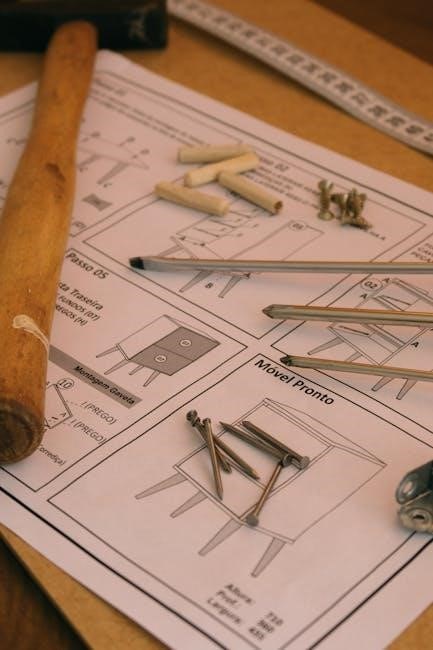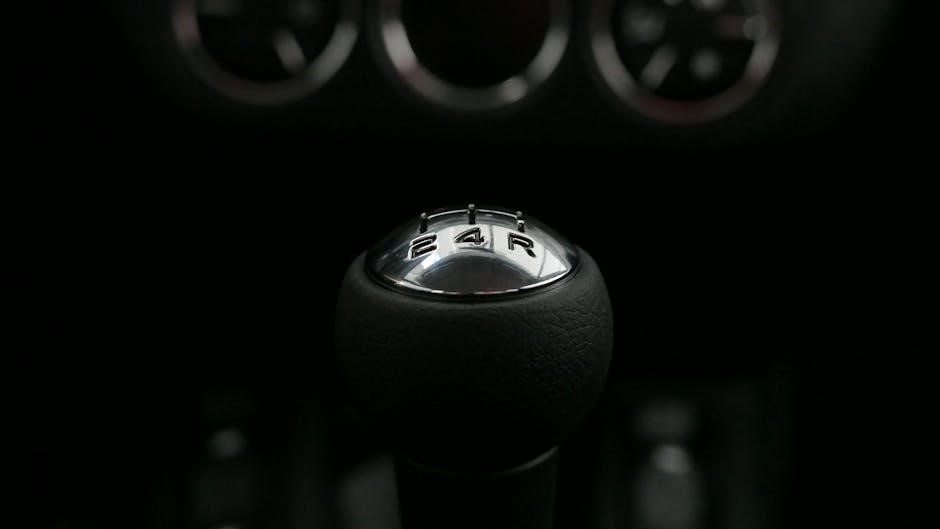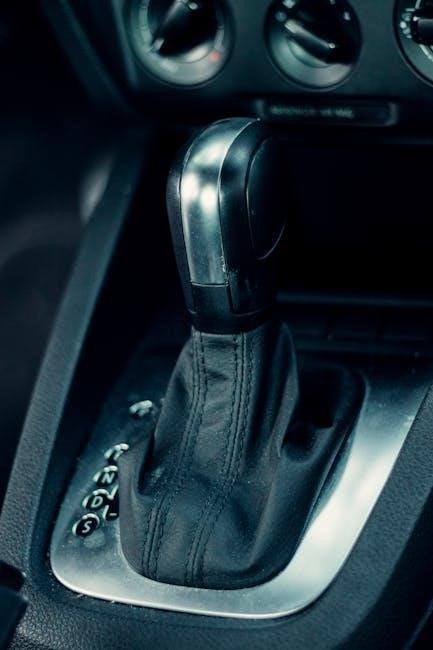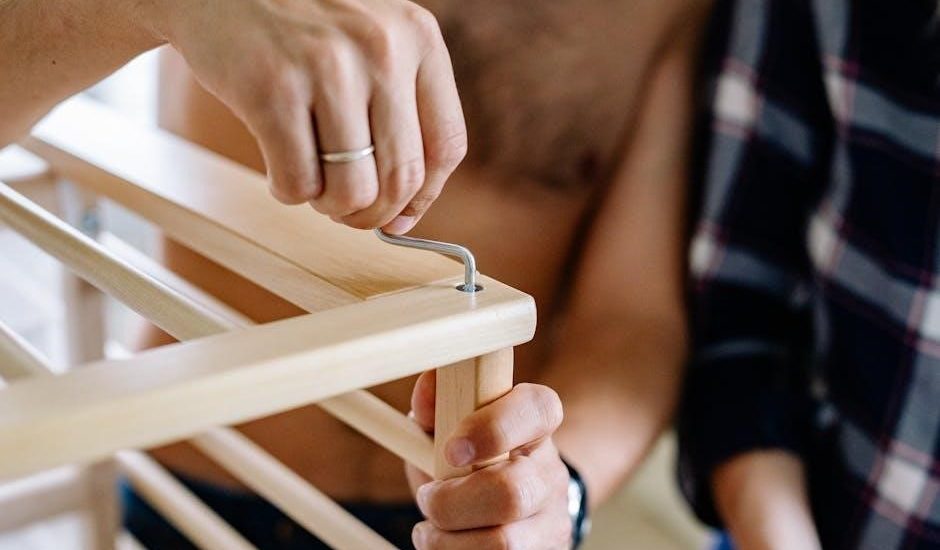The manual transmission shifter assembly is a critical component that connects the driver to the gearbox, enabling precise gear selection. It consists of key parts like the shift knob, gear lever, and linkage, ensuring smooth transitions between gears. This mechanism is vital for driver control and optimal vehicle performance, blending mechanical efficiency with ergonomic design.
1.1 Overview of the Manual Transmission System
The manual transmission system is a crucial automotive component that enables drivers to control gear shifts manually. It relies on a complex interplay of mechanical parts, including the shifter assembly, gearbox, and clutch. This system provides precise control over speed and torque, making it popular for performance and fuel efficiency. Manufacturers like Hurst and Lokar offer high-quality shifter solutions. The manual transmission system remains essential for driver engagement and is even being adapted for use in electric vehicles, as seen in Ford’s recent patent for a simulated manual shifter in EVs.
1.2 Importance of the Shifter Assembly
The shifter assembly is integral to the functionality of a manual transmission system, acting as the direct link between the driver and the gearbox. It facilitates smooth gear transitions, ensuring control and precision while driving. A well-designed shifter assembly enhances driving performance and reduces wear on transmission components. Its durability and reliability are crucial for maintaining optimal vehicle operation. Additionally, the shifter assembly’s ergonomic design contributes to a more comfortable and engaging driving experience, making it a key factor in both vehicle performance and driver satisfaction.
1.3 Brief History of Manual Transmission Development
The manual transmission system has evolved significantly since its inception in the early 20th century. Early designs were rudimentary, with manual gear shifting becoming more refined in the mid-20th century. The introduction of the Hurst shifter in the 1950s revolutionized the industry, offering precise control and durability. By the 1980s, advancements in materials and engineering led to the development of short shifter kits and ergonomic designs. Today, manufacturers like Hurst, Lokar, and B&M continue to innovate, blending performance-driven designs with modern technology to enhance the driving experience.

Key Components of the Manual Transmission Shifter Assembly
The manual transmission shifter assembly consists of the shift knob and boot, gear lever and linkage, and shifter mechanism with interlock system for smooth gear transitions.
2.1 Shift Knob and Boot
The shift knob and boot are essential components of the manual transmission shifter assembly. The shift knob serves as the driver’s interface, providing a comfortable grip and precise control during gear shifts. It is typically made from materials like leather, rubber, or aluminum for durability and aesthetics. The boot, or shift boot, encases the shifter mechanism, protecting it from dust and debris while maintaining a clean appearance. Together, they ensure smooth operation and enhance the driving experience. Replacing worn-out boots or knobs can improve both functionality and the overall look of the shifter assembly.
2.2 Gear Lever and Linkage
The gear lever and linkage are crucial components of the manual transmission shifter assembly, responsible for transmitting the driver’s gear selection to the transmission. The gear lever is the visible stick that the driver operates, while the linkage connects it to the transmission’s internal mechanisms. Designed for durability, the linkage is typically made of robust materials to withstand frequent use. Proper alignment and minimal wear are essential for smooth, precise shifting. Any misalignment or wear can lead to difficulties in selecting gears, highlighting the importance of regular maintenance to ensure optimal performance;
2.3 Shifter Mechanism and Interlock System
The shifter mechanism and interlock system ensure smooth and accurate gear transitions, preventing misalignment or accidental shifts. The mechanism translates the driver’s movements into precise gear changes, while the interlock system physically blocks incorrect shifts, such as shifting from reverse to drive without stopping. This safety feature is critical to avoid transmission damage. Modern designs often integrate detents and spring-loaded components to enhance feel and reliability. Regular maintenance, like lubricating pivot points, keeps these systems functioning seamlessly, ensuring driver control and transmission longevity.

Manufacturers and Their Offerings
Prominent brands like Hurst, Lokar, and B&M offer high-quality manual transmission shifter assemblies, catering to various vehicles, including Ford, GM, and Mopar. Their products ensure durability and precision shifting.
3.1 Hurst Shifter Assembly
Hurst shifter assemblies are renowned for their durability and precision, offering models like the Competition/Plus and Indy Universal. They feature sturdy constructions, ensuring smooth, precise gear shifts. Hurst shifters are compatible with popular transmissions, including Borg Warner and Tremec, making them a top choice for both enthusiasts and racers. Their designs emphasize ergonomic comfort and mechanical efficiency, enhancing the overall driving experience. With a focus on quality, Hurst continues to be a trusted name in manual transmission components.

3.2 Lokar Shifter Assembly
Lokar shifter assemblies are celebrated for their innovative designs and versatility. Known for their adjustable shifters, Lokar offers models like the Midnight Series and Classic Series, combining style with functionality. Constructed from high-quality materials such as aluminum and stainless steel, these shifters ensure durability and resistance to wear. They are compatible with a wide range of manual transmissions, including those from Borg Warner and Tremec. Lokar shifters also feature ergonomic shift knobs and boots, enhancing driver comfort. Their reputation for reliability and performance makes them a favorite among enthusiasts and custom builders.
3.3 B&M Shifter Assembly
B&M shifter assemblies are renowned for their precision engineering and robust construction. They offer a variety of models, including the popular Pro Stick and Magnum Grip series, designed for both performance and durability. B&M shifters are compatible with multiple manual transmission types, such as Muncie and Jerico, and are often preferred by racers and enthusiasts. Their adjustable features allow for customized shifting, while their high-strength materials ensure long-lasting performance. With a focus on delivering smooth, consistent shifts, B&M shifters are a trusted choice for those seeking reliability and control.

Installation and Adjustment of the Shifter Assembly
Installing a manual transmission shifter assembly requires precise alignment and adjustment to ensure smooth gear engagement. Proper setup involves securing the assembly, adjusting linkages, and verifying compatibility with the transmission. Ensuring the shifter is in neutral and aligning the mechanism correctly are critical steps for optimal performance and reliability. Regular adjustments may be needed to maintain precise shifting over time.
4.1 Step-by-Step Installation Guide
Installing a manual transmission shifter assembly involves several precise steps. First, ensure the vehicle is in neutral and apply the parking brake. Remove the old shifter by disconnecting the linkage and electrical connectors. Next, install the new shifter assembly, aligning it with the transmission’s input shaft. Secure it with bolts, ensuring proper torque specifications. Reconnect the linkage and electrical components, then test the shifter through all gears to confirm smooth operation. Adjustments may be necessary for optimal performance. Always refer to the manufacturer’s instructions for specific details.
4.2 Adjusting the Shifter for Optimal Performance
Adjusting the shifter assembly ensures smooth and precise gear changes. Begin by loosening the mounting bolts and aligning the shifter with the transmission’s gear lever. Tighten the bolts gradually, ensuring even pressure. Next, adjust the shift linkage to eliminate play, using the provided adjustment points. Lubricate the pivot points and bushings to reduce friction. Finally, test the shifter through all gears to confirm smooth operation and make fine adjustments as needed. Proper alignment and lubrication are key to achieving optimal performance and longevity of the shifter assembly.

Common Issues and Solutions
Common issues with manual transmission shifters include hard shifting and worn-out bushings. Regular lubrication and timely replacement of worn parts can resolve these problems effectively.
5.1 Hard Shifting: Causes and Fixes
Hard shifting in manual transmissions often stems from worn synchronizers, low transmission fluid levels, or misaligned gear teeth. To address this, inspect and replace damaged components, refill fluids to the recommended level, and adjust shift linkage for proper alignment. Regular maintenance, such as lubricating moving parts and checking for wear, can prevent these issues. If problems persist, consulting a professional mechanic is advisable to avoid further damage to the transmission system.
5.2 Worn-Out Shifter Bushings: Replacement Guide
Worn shifter bushings can cause sloppy shifting and uneven gear engagement. To replace them, start by removing the shifter assembly and disassembling it to access the bushings. Next, remove the old, worn bushings and clean the area to ensure proper fitment. Install new bushings, applying a small amount of lubricant for smooth operation. Reassemble the shifter and test its performance. For a more durable solution, consider upgrading to solid metal bushings, which offer improved longevity and precision shifting. Always refer to your vehicle’s manual for specific instructions.

The Role of the Shifter Assembly in Electric Vehicles
In EVs, shifter assemblies simulate manual transmission experiences, offering drivers a familiar interface. Ford’s patent introduces a gear lever replicating manual shifting patterns, enhancing engagement without traditional gears.
6.1 Simulated Manual Transmission in EVs
Electric vehicles are adopting simulated manual transmissions to enhance driving engagement. Ford’s innovative shifter assembly replicates the feel and function of traditional manual shifting, despite the absence of physical gears. This system uses electronic controls to mimic the familiar gear-lever movements, providing drivers with a sense of connection to the vehicle’s operation. The simulated shifting experience is achieved through programmed resistance and feedback, allowing EVs to offer a fun, interactive driving experience akin to conventional manual transmissions, but without the mechanical complexity.
6.2 Ford’s Shifter Assembly Patent for EVs
Ford has developed a revolutionary shifter assembly for electric vehicles, detailed in a recent patent application. This system replicates the feel and function of a manual transmission, allowing EVs to offer a simulated shifting experience. The design includes a gear lever that mimics the mechanical interaction of traditional manual shifting, even though EVs lack physical gears. By integrating electronic controls, Ford aims to create a more engaging and interactive driving experience, blending nostalgia with modern technology to appeal to enthusiasts of manual driving.

How to Choose the Right Shifter Assembly
Selecting the right shifter assembly involves considering compatibility with your vehicle’s make and model, durability, and ease of use. Prioritize quality materials and brand reputation for reliability. Ensure the assembly aligns with your driving style and vehicle specifications for optimal performance.
7.1 Factors to Consider
When selecting a shifter assembly, consider vehicle compatibility, ensuring it fits your car’s make, model, and year. Assess the build quality and materials for durability. Think about your driving style and whether you need a short shifter for quicker shifts or a standard setup for comfort. Brand reputation matters, as trusted brands like Hurst or Lokar offer reliable performance. Also, evaluate the ease of installation and whether you need additional tools or expertise. Finally, check for warranty and customer support for long-term satisfaction.
7.2 Compatibility with Vehicle Make and Model
Ensuring the shifter assembly is compatible with your vehicle’s make and model is crucial for proper function. Research the specific transmission type and its gear configuration to match the shifter’s design. Consider mounting points and console layout to ensure a seamless fit. Many shifters are tailored for popular models like Ford, GM, or Nissan, so check manufacturer specifications for compatibility. Using an incompatible shifter can lead to installation issues or poor shifting performance, emphasizing the need for precise matching before purchase.

Maintenance and Upgrades
Regular lubrication and inspection of the shifter assembly ensure smooth operation. Upgrading to a short shifter kit enhances precision and reduces throw distance for better performance.
8.1 Regular Maintenance Tips
Regular maintenance ensures the longevity and smooth operation of the manual transmission shifter assembly. Inspect the shift knob and boot for wear, replacing them if necessary. Lubricate the gear lever and linkage to prevent friction and corrosion. Check the shifter mechanism for any looseness and tighten bolts as needed. Clean the assembly regularly to remove dirt and debris that could interfere with shifting. Additionally, monitor the transmission fluid level, as low levels can affect shifting performance. Addressing these issues promptly helps maintain optimal functionality and driver control.
8.2 Upgrading to a Short Shifter Kit
Upgrading to a short shifter kit enhances shifting precision and reduces throw distance, offering a sportier driving experience. These kits are compatible with popular transmissions like Borg Warner, Muncie, and Tremec. Installation involves replacing the stock shifter with a shorter lever and often includes lightweight components. Proper alignment and lubrication are crucial for smooth operation. Many enthusiasts opt for brands like Hurst or Lokar, which offer durable, high-performance short shifters. Ensure compatibility with your vehicle’s make and model before upgrading. This modification is ideal for drivers seeking quicker, more responsive gear changes.
9.1 Summary of Key Points
The manual transmission shifter assembly is a critical system enabling precise gear control. It includes essential components like the shift knob, gear lever, and linkage. Top manufacturers such as Hurst and Lokar offer high-quality shifter assemblies designed for durability and performance. The assembly plays a vital role in driver control and vehicle performance; Innovations like simulated manual transmissions in EVs highlight its evolving relevance. Regular maintenance and upgrades, such as short shifter kits, can enhance functionality. Understanding compatibility and proper installation ensures optimal operation, making the shifter assembly indispensable for both traditional and modern vehicles.
9.2 Future of Manual Transmission Shifter Assembly
The future of manual transmission shifter assemblies lies in innovation and adaptation to emerging automotive trends. Electric vehicles are integrating simulated manual transmissions, offering drivers a familiar experience. Advances in materials and technology aim to enhance durability and performance. Customization options, such as short shifter kits, will likely expand. Additionally, manufacturers are exploring eco-friendly designs and energy-efficient solutions. As vehicles evolve, the shifter assembly will remain a vital component, blending tradition with modern engineering to meet the demands of tomorrow’s drivers while maintaining the thrill of manual shifting.

Additional Resources
Explore top retailers like JEGS, CARiD.com, and Summit Racing for parts. Visit DiffsOnly.com for specialized components. Join online forums for expert advice and community support.
10.1 Recommended Tools and Parts Suppliers
For high-quality tools and parts, consider JEGS, CARiD.com, and Summit Racing. These suppliers offer a wide range of manual transmission shifter components, including shift knobs, boots, and complete assemblies. JEGS provides parts from top brands like Hurst and Lokar, while CARiD.com ensures low prices and expert support. For specialized needs, DiffsOnly.com offers high-quality, affordable components. These retailers cater to various vehicle makes and models, ensuring compatibility and performance. Their extensive catalogs and customer service make them reliable choices for enthusiasts and professionals alike.
10.2 Online Communities and Forums
Online forums like Reddit’s r/MechanicAdvice and r/DIY offer valuable insights and troubleshooting tips for manual transmission shifter assemblies. Specialized forums dedicated to specific vehicle brands, such as Honda Civic or Ford Mustang communities, provide targeted advice. Facebook groups focused on car enthusiasts also serve as platforms for discussing repairs and upgrades. These communities are excellent resources for connecting with experts, sharing experiences, and finding solutions to common issues. They often include detailed guides, part recommendations, and real-life success stories to help enthusiasts maintain or upgrade their shifter assemblies effectively.





